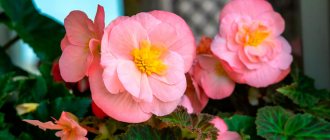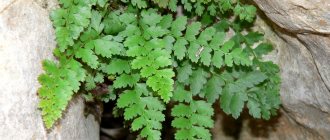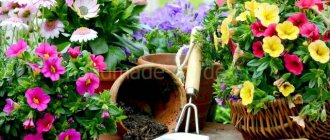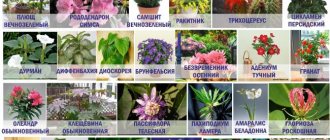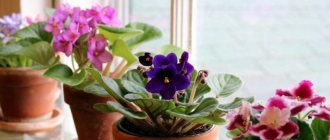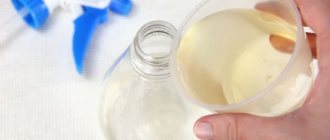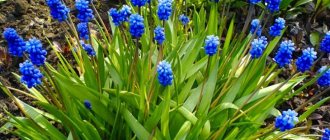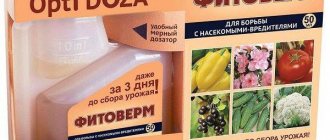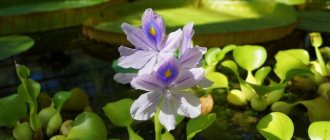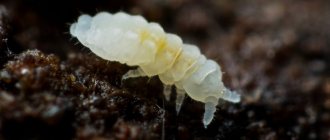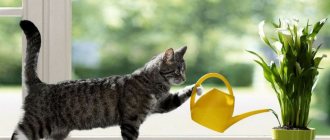Having a greenhouse of indoor plants at home is not only beautiful, it has a beneficial effect on the surrounding atmosphere. After all, plants are able to purify the air by converting carbon dioxide into oxygen. But how to install this “filter” in the house if there is little light and no time at all to create a microclimate? In such a situation, preference should be given to shade-loving and unpretentious subspecies of ornamental plants. They have advantages:
- They provide maximum oxygen in dark places; some species are only able to filter the air at night. Perfect for the bedroom.
- They do not require frequent watering and fertilizing.
- There is no need to create a special microclimate.
There are a large number of subspecies of shade-loving plants, this article will help you make a choice - it will tell you about popular plants, their advantages and disadvantages, and how to avoid mistakes when choosing.
Little flowering, non-flowering
Bordered, Draco
These are varieties of dracaena that are distinguished by their beauty and are not capricious to living conditions. They can be kept in the darkest corners of the apartment.
Dracaena can be found in many offices and institutions, attracted by its exotic appearance and unpretentiousness.
In favorable conditions it can grow up to 5 meters in height. Artificial lighting has a good effect on the development of the plant.
Advantages:
- water no more than once a week;
- transplantation is carried out once a year;
- does not require fertilizing.
Flaw:
- in dark corners it practically does not bloom.
Sansevieria
It is better to start with this species for those who are just trying to make friends with house plants. Sansevieria grows well in any conditions. Tolerates drought or humidity easily. The plant rarely develops color, but if you maintain optimal conditions without changes, you can find flower buds.
Care is simple:
- watering once every 7-9 days;
- Irrigate foliage only in hot weather;
- fertilize the soil once every 6 months;
- transplantation is carried out after growth.
Advantages:
- loves translucent places;
- grows well at temperatures above 14 degrees;
- give maximum oxygen.
Flaws:
- in winter, additional lighting is required;
- doesn't like drafts.
Hibiscus
Everyone's favorite Chinese rose with large beautiful buds. This plant not only serves as home decoration, but is also used in the treatment of many diseases. Hibiscus leaves contain a large list of vitamins.
Advantages:
- fertilize the soil no more than once every 4-5 weeks;
- You can completely eliminate fertilizers, but the plant will not bloom.
Flaws:
- mandatory placement with little access to light;
- moistening the soil once every 7-9 days;
- It is necessary to create a special microclimate.
Fatsia japonica
The plant does not require the creation of certain climatic conditions, loves the darkest corners of the room and even grows well near heating devices. The flower is perfect for the bedroom, as flower growers claim that fatsia has a beneficial effect on sleep.
Advantages:
- humidifies the air;
- low probability of parasites and infection with any disease.
Flaws:
- Not identified.
Geranium
A beautiful flowering house plant that gains color even with infrequent care. It is better to place a flower pot on the east or west side. It is enough to moisten the soil several times every 14 days.
Advantages:
- no special microclimate is required;
- the aroma cures headaches.
Flaw:
- In order for geranium to bloom profusely and for a long time, it is necessary to apply complementary foods once a month.
Aspidistra tall
If you grow this plant only in the shade, then you should purchase aspidistra varieties with a purely green color.
Advantages:
- not demanding on microclimate;
- subcortices are rarely done.
Flaws:
- stagnation of water has a bad effect on the leaves;
- It is important to avoid direct sunlight.
Aglaonema variable
The indoor flower is varied in varieties and colors, from golden to gray shades.
Dense foliage creates a wonderful decoration for the room, unpretentious to the microclimate.
Advantages:
- capable of growing in the darkest corners.
Flaw:
- It is necessary to carefully monitor soil moisture.
What kind of shadow is there?
We will help you figure out what degree of shading is in a particular place on your garden plot:
Shadow
Shady areas are considered to be places where direct sunlight hits for 2 - 3 hours a day.
Penumbra
These are areas where the sun's rays fall 3 - 4 hours a day. This happens either in the morning at sunrise or in the evening at sunset. Such a shadow is formed from the wall of a house or a fence; accordingly, shady and sunny areas will alternate.
Scattered Shadow
Such a shadow is formed when sunlight passes through the crowns of trees. Areas with diffuse shade are favorable for growing many plants.
deep shadow
There are places where sunlight does not reach, this may be due to the certain architecture of your garden area. Sunlight does not reach this place due to the placement of buildings on your plot.
Gain color all year round
Among the shade-loving plants, there are plants that are able to constantly gain color in the shade; with the presence of bait, flowering can be abundant. Flowering plants are more demanding on the microclimate. For your reverent attitude towards yourself, they reward you with beautiful flowers that will decorate any corner of the apartment.
Male happiness - anthurium
Atrium is considered to be a male enhancement enhancer. Many people are skeptical about this, but they still grow the flower in their apartment. Requires minimal cost per move.
Advantages:
- loves dark corners of the room, ultraviolet radiation from direct rays is harmful, the sun can damage the leaves. If you still place it near a window, it is better on the east or west side;
- Blooms beautifully without the presence of complementary foods.
Flaws:
- It is advisable to monitor soil moisture; the soil should not be dry;
- Regular complementary feeding will ensure continuous flowering.
Pelargonium
A popular flower among lovers of indoor floriculture. The plant can be placed in any corner of the room; in the shade the flower will stretch in height, and in the sun it will grow in breadth.
Advantages:
- gains color all year round and constantly.
Flaws:
- it is necessary to constantly maintain soil moisture;
- If you want to grow a neat bush, you should constantly trim off the faded buds.
Begonia royal
This variety of begonia is suitable for those who plan to have flowering, unpretentious house plants. The flower is not sensitive to its location; it only needs a little ultraviolet light to bloom.
There are a large variety of begonia varieties, but flower growers prefer decorative royal begonia, since the lack of flowering is compensated by the presence of gorgeous leaves of various colors.
Advantages:
- Gorgeous appearance even without flowering.
Flaws:
- loves abundant watering, but at the same time not allowing moisture to stagnate in the pot;
- Trim the roots in time, as begonia can grow profusely and take a long time to gain color.
Spathiphyllum
This indoor flower will appeal to those who love feces. The plant produces white flowers consisting of one petal. It is worth placing the flower in places where the sun's rays will not fall on the leaves. Due to direct contact, the foliage quickly turns yellow.
Advantage:
- flowering all year round is more intense in the summer.
Flaw:
- You will have to constantly monitor soil moisture, otherwise flowering will disappear.
Kalanchoe
A flowering plant that loves summer. It is advisable to place it in a semi-shaded place. Will decorate with flowering all year round.
Advantage:
- You don’t have to think about Kalanchoe for a month; even in dry soil it grows well.
Flaws:
- When forming seeds, the plant literally shoots them all around, which forces you to frequently tidy up around the plant.
Chlorophytum
A hanging plant with drooping shoots. Perfectly decorate a wall in a room with poor light transmission. Resistant to changes in microclimate in the apartment.
Advantage:
- the root system is designed in such a way that it takes in water gradually, and within two weeks the flower does not need watering;
- does not require the creation of special microclimate conditions.
Flaw:
- To prevent the foliage of chlorophytum from drying out quickly, spraying should be carried out constantly.
Alocasia
The plant can germinate perfectly in the darkest corner of the apartment and still produce flowers. However, for the plant to exist comfortably in the shade, painstaking work is required.
- First, it is planted in a special mixture, the ingredients of which resemble soil for growing orchids;
- There should always be moisture in the soil. Therefore, a strict watering schedule is developed.
Advantage:
- absolutely does not require light;
- It can even bloom.
Flaw:
- demanding on watering.
Epipremnum
If you need to decorate the interior of an apartment with insufficient lighting, you should purchase epipremnum. This climbing plant will perfectly decorate the room and does not require any costs to care for. Withstands various microclimatic conditions. Grows up to 3 meters.
Advantages:
- soil moisture is rare;
- does not require feeding.
Flaws:
- in the complete absence of light, the foliage loses its mottled appearance, but the decorative effect is preserved.
Ecological information: groups of plants in relation to light
In relation to the most important abiotic factor, three ecological groups of plants are distinguished:
- Light-loving plants (heliophytes) are inhabitants of open, sunny spaces. In nature, this is meadow, steppe, coastal and aquatic vegetation. These include most cultivated species and weeds.
- Shade-loving (shadow) - inhabitants of the lower tier of coniferous and deciduous forests. For normal existence, they need from 0.1 to a third of the norm of full illumination. The sun has a depressing effect on them.
- Shade-tolerant - quite tolerant of light, that is, they grow better in full light, but tolerate light shade. These are representatives of the mixed forest phytocenosis (for example, snowdrops, lily of the valley). Astilbe, hosta, bergenia, aquilegia, kupena, cereals, sedum, lupine, and delphinium have taken root well in the garden.
Perennial plants, well adapted to a lack of sunlight, are distinguished by species diversity, decorativeness, unpretentiousness, and ease of care.
Creating a shady flower bed from perennials follows general rules. Different types are selected according to height : the tallest ones are planted in the center or in the background of the flower garden, followed by medium-sized ones, and low ones and ground cover along the edges and in front. This arrangement prevents neighbors from further shading each other, helps demonstrate their beauty, and emphasizes the harmony of combinations.
Indoor large sizes. Palm trees
You can diversify your interior or add a touch of exoticism to your home atmosphere with the help of decorative palm trees or large trees. However, in most cases this is a costly affair and requires painstaking work to create special climatic conditions for the germination of exotic plants at home. Large-sized and indoor palms do not tolerate frequent transplants and drafts. For those who do not have the time to look after and provide proper care for such plants, it is recommended to purchase unpretentious varieties. There are several of the most popular types.
Hamedorea
The plant takes root in any home climatic conditions, does not require excess light and other factors, since it can grow in the proposed conditions.
Advantages:
- no need to think about transplantation, it is necessary no more than once every 1-1.5 years.
Flaw:
- In order for the palm tree to gain growth, intensive watering is required at a certain growth phase.
Howea Forster
Externally, it has larger leaves and stems than chamedoria.
Advantages:
- unpretentious;
- can withstand drought.
Flaw:
- if growth is needed, then the howea must be irrigated and fed constantly.
Dangerous house flowers
Some types of flowers can release toxic substances to pets and can also be dangerous to people. Despite the warnings, many people safely keep such plants at home.
- Philodendron (dangerous for cats; if an adult or child eats a piece of the plant, minor side effects will occur);
- Syngonium (causes vomiting in humans and animals if a piece is eaten);
- Spathiphyllum (the most dangerous type of flower, if it gets into the stomach it causes serious consequences);
- Dieffenbachia (causes mild symptoms of poisoning).
Shade-tolerant ground covers
Groundcover (carpet) is a group of low-growing (up to 30 cm) plants, the main feature of which is the ability to quickly grow and occupy large areas of garden space.
In the shady corners of the dacha, between taller crops, under trees you can safely plant periwinkle , budra , heuchera , creeping tenacious, European hoofweed , lungwort, nettle-leaved mikhina , pachysandra, spleenwort , gooseberry , tiarella , and clearweed . All of them form a kind of carpet, decorative for a long time, and evergreen species (periwinkle, pachysandra) persist even in winter.
Creeping tenacious (ayuga, aishuga)
A low, pubescent plant from the Lamiaceae family. The leaves are oval, the lower ones form a basal rosette, from which quickly rooting shoots – tendrils – grow. Blooms from April to July. The peduncle has a tetrahedral stem up to 35 cm high. The two-lipped blue flowers are collected in spike-shaped inflorescences, which remain beautiful for a long time even after flowering. Propagated by seeds, division, cuttings.
Today, many varieties of creeping tenacious have been bred, differing in the shape and color of the leaves.
Lungwort
A representative of the Borachnikov family has a rough stem, lanceolate pubescent leaves and flowers of pink, blue, and white colors, blooming on one plant. This is a good honey plant, hence the Russian name of the flower.
The most popular among flower growers are variegated (variegated) varieties of lungwort: white and silver spots can be located pointwise, in the center, or in the form of a border along the edges of the leaf.
Pachysandra
A little-known evergreen ground cover from the Boxwood family. Valued for its beautiful, unusual shape of glossy leaves, fast growth, unpretentiousness, and frost resistance. Grows under trees, along garden paths, and even tolerates full shade.
Pachysandra apex is most often grown in culture.
Fashionable shade-loving plants: how much does it cost to buy?
Houseplants that love shade can be purchased at any specialty store. In terms of price, there are both inexpensive varieties and those whose average price is not affordable for everyone. Among the most popular types of shade-loving flowers are:
- Hamedorea
indoor palm tree with feathery leaves. Unpretentious in care, the only thing that needs to be observed is the thermal regime. Price: in the aisles 300 rubles.
Advantage:
- If you plant several palm trees together, you will get dense thickets.
Flaw:
- You will have to constantly spray the foliage.
- Aucuba japonica
A beautiful plant with gold flecks on the foliage. Price: in the aisles 400 rubles.
Advantages:
- Does not require the creation of climatic conditions;
- Rare watering is possible.
Flaw:
- all parts of the plant are poisonous.
- Philodendron
A type of vine that grows up to two meters in length. Will perfectly decorate the interior of any apartment. Easy to care for. Budget varieties can be purchased for only 100 rubles.
Advantages:
- This plant will adapt to any conditions.
Flaws:
- No.
- Epipremnum pinnate
More often found as a plant with lush foliage. The most popular flower among gardeners. Price: 250 rubles.
Advantages:
- tolerates dry air well;
- perfectly purifies indoor air from germs.
Flaws:
- requires fertilizing and watering control.
Tall perennials
Giants from this group can reach a height of up to 200 cm. These are aruncus, buzulniki (Przhevalsky, Wich, narrow-leaved, palmate, serrated), delphinium, daylilies, branched cohosh.
Arunkus vulgaris (volzhanka)
Belongs to the Rosaceae family. The leaves are large, petiolate, bipinnate. Inflorescences are a complex panicle formed by white or cream small flowers. Flowering time is June.
Volzhanka can be advantageously camouflaged for buildings, fences, and can be used to create areas under the canopy of sparsely planted trees.
Among the tall ones, it is worth special mentioning the shade-loving flowers for the garden, blooming all summer:
Black cohosh (black cohosh)
Belongs to the Buttercup family. It is distinguished by very beautiful, dissected leaves and characteristic snake-like writhing inflorescences of small whitish flowers, which open gradually, starting from the bottom. Black cohosh blooms from June to autumn. It is propagated by dividing the bush, cuttings, and seeds.
Black cohosh inflorescences emit a not very pleasant smell, apparently this is where the name of the plant comes from
Buzulnik
The genus Buzulnik of the Astrov family includes about 150 species. They reproduce by seeds and division of the bush. They love watering and fertile soil.
Buzulnik serrated is a powerful herbaceous perennial with oval-round leaves. Yellow flowers are collected in baskets, up to 10 cm in diameter. The baskets form complex umbrellas.
Buzulnik serrated blooms all summer; varieties with unusual foliage colors look especially impressive.
Przhevalsky's buzulnik is distinguished by red-brown stems and openwork leaves dissected along the edges. The inflorescences are paniculate, resembling candles. Flowering occurs in June – July.
Having taken a strong position in the gardens of central Russia, Przhevalsky's buzulnik is found in wild flora in the Urals and China.
How to choose a plant
To buy a flower that is necessary for specific living conditions, you should adhere to certain points.
What to look for when choosing:
- remember that if unpretentious plants are the object of choice, they should still be cared for, even minimally;
- You should only purchase plants in special stores; the consultant will give a full description and tell you how to care for the flower;
- clearly understand where you want to place the flower pot;
- When purchasing, pay attention to the general condition of the plant; it should be rich in color, without dry leaves or signs of disease;
- The soil condition should not be dry or too wet.
Safety for plants
All types of houseplants are prone to disease or pest damage. Some to a greater extent, some to a lesser extent.
It is necessary to carry out preventive measures:
- You should carefully examine the leaves of the flower from the outside and inside. This must be done upon purchase, and also inspect the plants in the apartment once a week.
- When planting, the container for the plant and bud must be heated or frozen, depending on the selected species.
- You need to know how to create a microclimate for flowers that are at risk.
If parasites are detected:
- Immediately isolate the plant from others, as pests spread very quickly;
- Collect pests by hand or rinse with a strong stream of water (repeat several times in a row);
- Wipe the leaves with a stiff brush dipped in soapy water.
- To combat persistent pests, use a soft cloth to wipe the leaves with a solution of alcohol or denatured alcohol;
- You can wipe the leaves with a decoction of garlic, hot pepper or onion for a month;
- It is not recommended to carry out chemical-based treatment at home, however, if there are a large number of pests, then you can use Fitoverm. It effectively fights many types of pests, while being absolutely safe for humans and pets.
Which house plant to choose?
From the description of the most popular types of shade-tolerant plants, we can conclude that if you need a flower that you don’t have time to care for, then you should choose unpretentious, low-flowering plants. If you are able to provide careful care, then flowering plants will delight you all year round.
Where is the best place to install the plant?
For a children's room, it is better to purchase sansevieria and all similar types of indoor plants. Their advantages are that they perfectly purify the air and do not require frequent wet cleaning of leaves. Also suitable for children is chlorophytum, which absorbs harmful substances from the air.
For the bedroom, it is better to choose Japanese fatsia, since in the dark it produces oxygen more actively and perfectly humidifies the air.
In the kitchen it is worth placing plants that require a small amount of light. Popular blooming flowers for the kitchen are begonias. Its leaves release essential oils, thanks to which it disinfects the air in the room.
You can place plants in the corridor that thrive in the darkest corners. Curly shade-loving flowers are suitable for decorating the corridor, the most popular are:
- Chlorophytum;
- Epipremnum;
- Tradescantia.
Choosing the right plant will allow you to decorate a space even where access to natural light is completely excluded. It is important to follow the rules for caring for the chosen flowers.
Spathiphyllum
Its homeland is the tropical forests of South America, the Philippines. It is an elegant plant with long, smooth green leaves and beautiful blooms. The inflorescence appears in the spring and looks like an ear, shrouded in a white blanket. Flower growers value spathiphyllum for the beauty of the leaves, the sophistication of the flower and for the legends that exist around it.
It is believed that it brings feminine happiness to its owner. If the spathiphyllum blooms, it means its owner will find her companion or she will have a baby.
For spathiphyllum to bloom, follow simple maintenance rules: high air humidity, lack of bright sunlight, slightly shaded place. Watering - as the soil dries out. All this allows you to use spathiphyllum anywhere in the apartment, even where there are no windows. Move closer to natural light only during flowering, or use fluorescent lamps.
Trees
European beech
Slightly moist nutrient soil is best suited for growing beech. It can be grown in a shady area.
Common ash
Ash is a fast-growing tree that is resistant to polluted air. Nutritious soil is best, but can also grow in soil of average fertility. To plant an ash tree, you can choose a semi-shaded area.
Mountain ash
The relatively low and stable mountain ash is a shrub or tree. This shade-loving crop is undemanding to the quality of the soil. In the summer-autumn period, the branches of the bush are decorated with spectacular red-orange berries.
Elm
Mountain and European elms prefer to grow in nutritious and moist soil. They are highly resistant to low temperatures and shade-tolerant. Susceptible to Dutch elm disease.
Canadian hemlock
Canadian hemlock is a coniferous shrub or tree. It grows best in areas with high humidity and nutritious soil. Dwarf varieties are grown in small garden plots. As a rule, they are planted on shady rockeries or ridges.
Herbs that tolerate shade well
In shaded areas, some herbaceous crops do quite well. Shade-loving herbs will be described in more detail below.
Ozhika forest and snow
Ozhika snowy
Ozhika forest and snowy is a perennial shade-tolerant plant that is quite popular among gardeners. It is often planted under bushes or trees. However, the hedgehog may die if it remains in deep shadow all the time.
Ozhika forest
Forest grass is an evergreen plant whose foliage is covered with long hairs.
Fescue
Swamp fescue, or gray fescue, or low sedge is a semi-evergreen or evergreen perennial plant belonging to the Poaceae family. It grows well in shaded areas.
Ferns
Ferns thrive in a shaded area, but they need moderately moist soil. The following types of ferns are most popular among gardeners:
- male shieldweed;
- common millipede;
- the bladder is fragile;
- common ostrich;
- multirow spinous.
Bladder brittle
Common ostrich
Brittle bladderwort
What plants to plant in shady areas
